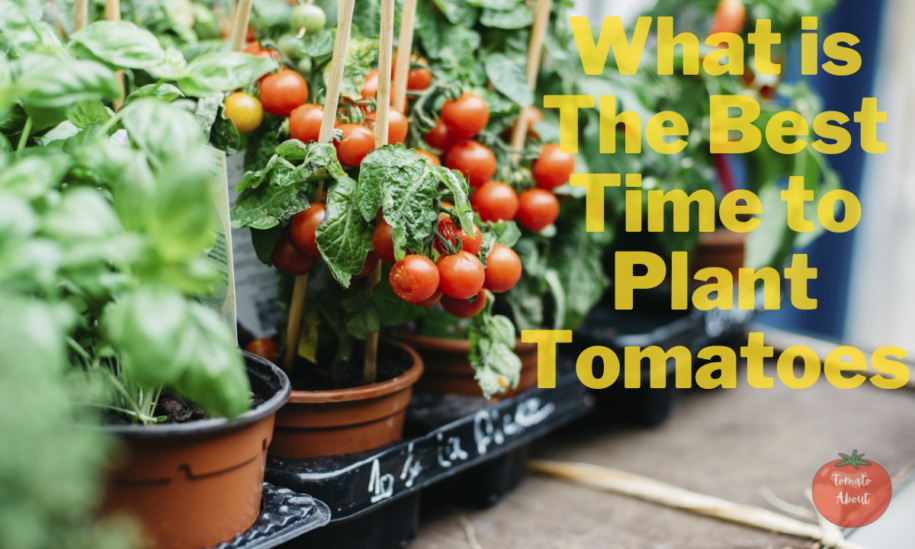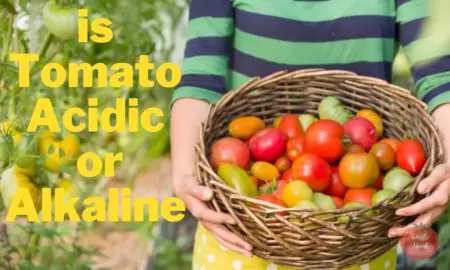Key Takeaways
- Base planting time on the average last spring frost date for your region.
- Wait to transplant tomatoes outdoors until night temps stay above 50°F consistently.
- Start seeds indoors 4-6 weeks before outdoor planting date based on your zone.
- Choose early variety tomatoes if planting mid to late season to allow time to mature.
- Create optimal conditions for growth like full sun, fertile soil, consistent moisture.
As soon as the first signs of spring arrive, every gardener starts dreaming about the taste of a fresh, vine-ripened tomato. Sweet, juicy, and bursting with flavor – nothing beats a tomato picked straight from your own garden.
But when’s the best time to plant these summer favorites so you can sink your teeth into ripe, red tomatoes later in the season?
Get it right, and you’ll be rewarded with bountiful harvests all summer long. Jump the gun too early, however, and your precious seedlings could get nipped by frost. Wait too long to plant and your tomatoes may not fully mature before winter sneaks up.
It’s a tricky balancing act, but have no fear! In this handy guide, you’ll discover all the insider tips and tricks for determining the perfect planting time for tomatoes in your area.
Let’s get growing!
Climate Is Key
Tomatoes thrive in warm and sunny conditions. In fact, anytime temperatures dip below 50°F, growth screeches to a halt. So the most important factor for deciding when to plant is your local climate and the last spring frost date.
Tomatoes are extremely frost-sensitive. Plant them too soon while nights are still chilly, and you’ll end up with blackened, wilted plants. Not a pretty picture.
That’s why it’s critical to know the average date of your last spring frost based on where you live. Your local extension service is a great resource for finding this data.
You can also get a ballpark estimate by looking at your USDA Hardiness Zone. This divides the country into zones based on each area’s minimum winter temperatures.
Once you know your zone, here are some general tomato planting guidelines:
Zones 3-4:
Wait to plant until late May when frost danger has passed.
Zones 5-6:
Plant tomatoes after the average last spring frost between mid-April to mid-May.
Zones 7-8:
Plant tomatoes as early as late March to early April.
Zones 9-10:
Plant tomatoes even earlier in February or March.
Of course, these are just starting points since microclimates can vary. Play it safe by waiting 2-3 weeks after the average last spring frost date if the weather is still temperamental. Remember, it’s always better to plant tomatoes a little late than too early!
Pick the Right Tomato Variety
Another important factor is choosing a variety suited to your growing season length.
Determinate tomatoes (bush types) grow to a compact size then produce their whole crop at once. Since they have a concentrated harvest time, you can plant them anytime during the season.
Indeterminate tomatoes (vining types) keep growing and fruiting all season long. To max out yields, these need to be planted as early as possible for a long warm season.
Also, pay attention to “days to maturity” on seed packets. Early varieties mature quickly in 50-60 days. Mid-season tomatoes take 60-80 days. Late-season types need a full 80+ days to produce.
If planting late, go for quick maturing early tomatoes. Hold off on planting long-season tomatoes if they won’t reach maturity before frost hits.
Varieties of heat-tolerant tomatoes
| Tomato Variety | Days to Maturity | Key Features |
|---|---|---|
| Arkansas Traveler | 90 days | Mid-late season, pink fruit |
| Big Beef | 73 days | Early, red beefsteak |
| Black Krim | 80 days | Mid-late, purple/black |
| Brandywine | 80+ days | Late, pink heirloom |
| Cherokee Purple | 80 days | Mid-late, purple |
| Super Sweet 100 | 65 days | Early, red cherry tomato |
Varieties of cold climate tomatoes
| Tomato Variety | Days to Maturity | Key Features |
|---|---|---|
| Bush Beefsteak | 60 days | Early, compact bush |
| Celebrity | 70 days | Mid-season, disease resistant |
| Husky Gold | 55 days | Early yellow tomato |
| Legend | 68 days | Early, red hybrid |
| Orange Pixie | 55 days | Early orange cherry |
| Oregon Spring | 60 days | Early, tolerates cooler temps |
Growing Season Duration
The length of frost-free days determines how much time tomatoes have to grow and fruit before the season ends. Count backwards from your first fall frost date based on the days to maturity for your variety. This gives you the latest date to plant.
For example, if your average first frost is October 15 and you have a 75 day tomato, you should plant no later than mid August. Always add a buffer of 1-2 weeks in case of an early frost.
When to Start Seeds Indoors
Starting seeds indoors gives you a head start on the season. Time it so seedlings are ready to transplant after all danger of frost is gone.
Here are planting times based on zones:
- Zones 3-4: Sow seeds indoors in early April. Transplant in late May to early June.
- Zones 5-6: Sow seeds indoors in late March. Transplant in mid to late April.
- Zones 7-8: Sow seeds in February to early March. Transplant in early to mid April.
- Zones 9-10: Sow seeds in January or February. Transplant as early as late February or March.
When transplanting, gradually introduce plants to outdoor conditions over 7-10 days (called hardening off). This prevents transplant shock.
When to Direct Sow Outdoors
You can sow seeds directly in the garden once soil temperatures reach at least 60°F. This works best for zones with long growing seasons. Cover seeds lightly with soil. They should sprout in 6-14 days.
Those in cooler regions can sow 4-6 weeks before the last average frost since seeds need cooler soil to germinate. Just be prepared to cover plants if a late frost comes.
Ideal Planting Times by Zone
Here is a breakdown of when to plant tomatoes based on your Hardiness Zone:
Zones 3-4
- Start indoors: 4-6 weeks before outdoor planting date
- Transplant outdoors: Late May to early June
- Direct sow outdoors: Not recommended
Zones 5-6
- Start indoors: 6-8 weeks before outdoor planting
- Transplant outdoors: Mid April to early May
- Direct sow outdoors: April
Zones 7-8
- Start indoors: 6-8 weeks before outdoor planting
- Transplant outdoors: Late March to mid April
- Direct sow outdoors: March
Zones 9-10
- Start indoors: 8-10 weeks before outdoor planting
- Transplant outdoors: February to March
- Direct sow outdoors: January to February
These timeframes maximize warm temperatures for rapid growth without risking plants to frost damage.
Few Additional Tips for Determining the Best Planting Time
Beyond your zone and variety, a few additional tips will help fine-tune the best planting dates:
- Watch the weather forecast about 2-3 weeks before your average last spring frost to see if an unusually late cold snap is coming. Hold off planting if frost is predicted.
- Track soil temperature, not just air temperature. Tomatoes need warm soil to thrive. Invest in a soil thermometer.
- Give it a buffer. Add 2 weeks before and after your estimated planting date range to play it safe from freak frosts.
- Start earlier for longer harvests. If you want tomatoes for months vs. weeks, plant as soon as your area allows.
- Plant late varieties at the start of your planting window. They need the whole season to mature fruit.
- Succession plant with early varieties over the whole season for multiple harvests.
Ideal Conditions for Planting tomatoes
Beyond timing, certain conditions create the optimal environment for your tomatoes during transplanting or sowing:
- Sunny spot. Tomatoes need a minimum of 6-8 hours of direct sunlight daily.
- Well-drained fertile soil. Amend with compost or fertilizer to provide nutrients. Acidic soil around pH 6.0-6.5 is ideal.
- Consistent moisture. Water plants deeply 1-2 inches per week. Use drip irrigation or soaker hoses.
- Shelter from wind. Sturdy cages, trellises and wind breaks prevent damage.
- Gradual introduction to outdoors. Harden off transplants for 7-10 days before planting outside.
Meeting these conditions ensures your tomatoes get off on the right foot when planted at the proper time.
Common Regional Planting Times
Here is an overview of appropriate planting times for major regions:
Midwest
The Midwest encompasses zones 5-6. Most gardeners start tomatoes indoors 4-6 weeks before the expected last frost between mid to late April. Transplant tomatoes outside in late April or May once soil reaches at least 60°F. Early June plantings can still produce crops before the first fall frost.
Northeast
Covering zones 5-7, the Northeast can transplant tomatoes outside between late April (for southern areas) to late May (for northern areas). Start seeds indoors 6-8 weeks prior. Some southern parts of the Northeast can direct sow seeds in mid-late April.
Southeast
Zone 6-8, the Southeast can transplant tomatoes as early as 4 weeks before the last average frost, which occurs from March-April. Direct sowing seeds can begin in March. Due to intense summer heat, it’s best to avoid July plantings.
Pacific Northwest
Spanning zones 5-8, the northwest transplant window runs from early April (for southern regions) to early June (for cooler northern areas). Sow seeds indoors 6-8 weeks beforehand. Direct sowing isn’t recommended due to the wet, cool springs.
Southwestern Desert
With mostly zones 9-10, the Southwest desert regions can transplant tomatoes as early as late February or March since frost risk is low. Start seeds indoors 8-10 weeks prior in January or February. Direct sowing can begin in February or March.
How Long Does It Take Tomatoes to Grow?
Once planted or transplanted, how long tomatoes take to fully develop depends on the variety. Here are general timeframes:
- Early season: 50-60 days
- Mid-season: 60-80 days
- Late season: 80+ days
Add approx. 1-2 weeks if growing from seedlings. The duration can vary based on growing conditions like sun exposure, soil quality, moisture and temperatures.
Containers may take 1-2 weeks longer than garden plants. But with the right care and timing, you can harvest tomatoes anywhere from 1 to 4 months after planting!
Tips for Planting Late in the Season
While it’s best to plant tomatoes at the start of your recommended window, you may decide to put them in later. Here are tips to still get a harvest from late plantings:
- Choose only early-season varieties, which take under 60 days to mature fruit from transplanting. Good bets are cherry, grape, plum, or sauce types.
- Start with large transplants. The bigger the plant, the faster the fruit will develop. Try 4-6 week old plants.
- Use season-extending devices like cold frames, cloches, or fabric row covers to protect plants from frost.
- Rely on a container or pot planting. They warm up faster than garden soil so plants grow quicker.
- Monitor the weather and be ready to cover or move containers if frost threatens. A cold snap can wipe out plants.
- Pick tomatoes prematurely before frost hits. They can ripen indoors on a sunny windowsill.
- Take advantage of microclimates that are warmer or more protected to delay frost damage.
Frequently Asked Questions
What are the signs that it is time to plant tomatoes?
Some signs it’s time to plant tomatoes include soil temperatures reaching 60°F, nighttime temps staying above 50°F, and your area’s average last spring frost date passing. Watch the weather forecast for warming trends
How do I choose which tomato variety to plant?
For early harvests, choose early-season tomatoes under 60 days. For mid-season, pick varieties that take 60-80 days. Late season types over 80 days produce best with longer summer climates. Select disease-resistant varieties if fungal issues are common in your area.
Should I fertilize when planting tomatoes?
Yes, add balanced fertilizer like 10-10-10 or tomato-specific fertilizer when transplanting or sowing seeds. Mix it into the soil per instructions. Side dress growing plants every 2-3 weeks. Fish emulsion and compost also feed tomatoes.
Wrapping up!
As you gear up for another tomato growing season, keep these timing tips in mind. Pay attention to your Hardiness Zone, weather patterns, variety traits, and tomato planting guidelines for your region.
Soon you’ll be ready to get those seeds started inside or directly in the garden! Trust me, all that planning and preparation will pay off tenfold once you bite into your first juicy, homegrown tomato of the season.


